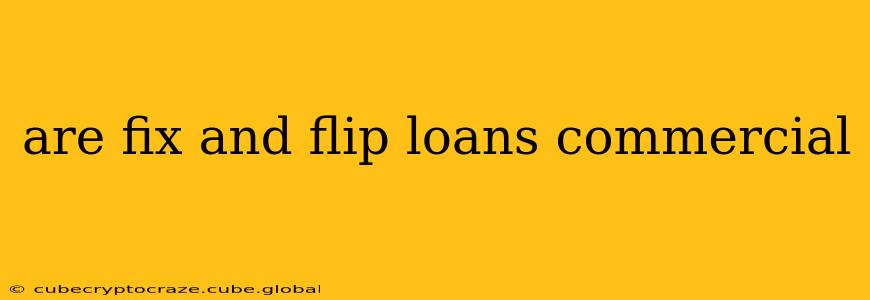Are Fix and Flip Loans Commercial? Understanding the Nuances
The question of whether fix-and-flip loans are commercial loans isn't a simple yes or no. It depends on several factors, and understanding these nuances is crucial for anyone considering this type of financing. While they share some characteristics with commercial loans, they're often treated differently. Let's delve into the specifics.
What is a Fix-and-Flip Loan?
A fix-and-flip loan is a short-term loan specifically designed for real estate investors who intend to renovate a property and quickly resell it for a profit. The loan amount is typically based on the after-repair value (ARV) of the property, minus the renovation costs and a lender's margin. This differs significantly from a standard mortgage, which is designed for long-term ownership.
What is a Commercial Loan?
A commercial loan is used to finance business activities, including the purchase, development, or improvement of commercial real estate. This broadly encompasses a wide range of properties, from office buildings and retail spaces to industrial properties and multi-family dwellings (depending on the number of units). The underwriting process is far more rigorous than residential lending, requiring detailed business plans and financial statements.
The Grey Area: Why Fix-and-Flip Loans Aren't Strictly Commercial (But Have Similarities)
While fix-and-flip loans involve the purchase and improvement of real estate – activities often associated with commercial lending – they aren't typically classified as commercial loans. Here's why:
- Short-Term Nature: Fix-and-flip loans have incredibly short repayment periods, often 6-12 months, vastly shorter than typical commercial loans.
- Focus on Resale: The intended use is the resale of the property, not long-term ownership and income generation, a defining characteristic of commercial real estate investment.
- Residential Properties: Most fix-and-flip projects involve residential properties, which are typically under the purview of residential, not commercial, lending guidelines.
However, fix-and-flip loans do share some characteristics with commercial loans:
- Higher Interest Rates: They carry higher interest rates than conventional mortgages due to the inherent risk involved.
- Stricter Underwriting: Lenders scrutinize borrowers' experience, creditworthiness, and the potential profitability of the project intensely.
- Focus on ARV: The loan amount is heavily influenced by the estimated ARV, a calculation commonly used in commercial real estate appraisal.
H2: What Types of Loans are Used for Fix and Flip Projects?
Fix-and-flip projects often utilize several types of financing, not just one singular type. Common options include:
- Hard Money Loans: These are short-term loans secured by the property, offered by private lenders and often characterized by high interest rates but faster funding.
- Private Money Loans: Similar to hard money loans, these come from private investors rather than institutional lenders.
- Fix-and-Flip Loans from Banks/Credit Unions: Some traditional lenders offer specialized fix-and-flip loan programs with competitive rates (but often stricter qualifying requirements).
H2: What are the Key Differences Between Fix-and-Flip Loans and Commercial Loans?
| Feature | Fix-and-Flip Loan | Commercial Loan |
|---|---|---|
| Loan Term | Short-term (6-12 months) | Long-term (5-25+ years) |
| Purpose | Resale of property | Business operations/ownership |
| Property Type | Primarily residential | Varied (residential, commercial) |
| Underwriting | Strict, focus on ARV | Strict, focus on business plan |
| Interest Rates | Generally high | Varies, dependent on many factors |
H2: Are there specific requirements for fix and flip loans?
Yes, lenders have stringent requirements. Expect scrutiny of your:
- Credit score: A good credit score is crucial.
- Experience: A proven track record in real estate investing is highly valued.
- Down payment: A substantial down payment is usually required.
- Business plan: A detailed plan outlining the renovation, marketing, and sales strategy is necessary.
- After Repair Value (ARV): A realistic ARV is essential to secure funding.
In conclusion, while fix-and-flip loans share some similarities with commercial loans, their short-term nature, focus on resale, and typical application to residential properties generally distinguish them. Understanding these distinctions is crucial for successfully navigating the fix-and-flip financing landscape. Always consult with a qualified financial advisor and lender to determine the most suitable financing option for your specific project.
